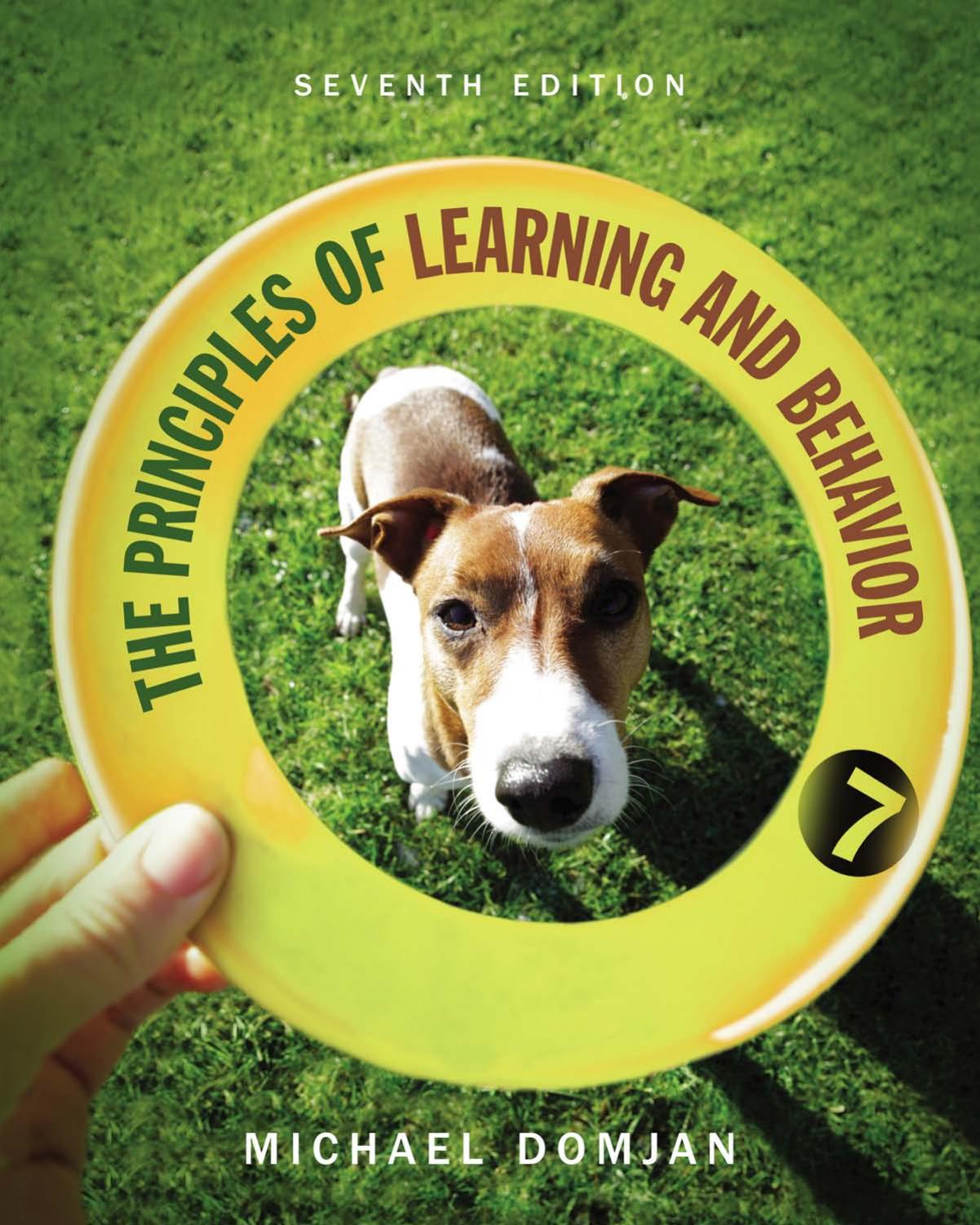The Principles of Learning and Behavior 7th edition by Michael Domjan ISBN 0357671016 9780357671016
$70.00 Original price was: $70.00.$35.00Current price is: $35.00.
Instant download Principles of Learning and Behavior 7th The Wei Zhi after payment
The Principles of Learning and Behavior 7th edition by Michael Domjan – Ebook PDF Instant Download/Delivery: 0357671016 , 9780357671016
Full download The Principles of Learning and Behavior 7th edition after payment

Product details:
ISBN 10: 0357671016
ISBN 13: 9780357671016
Author: Michael Domjan
From habituation, classical conditioning, and instrumental conditioning to stimulus control, aversive control, and their applications to the study of cognition, this learning and behavior textbook provides a comprehensive introduction to the elementary forms of learning that have been the focus of research for much of the 20th century. Applications boxes help you understand how findings from animal research relate to human learning and behavior, while neuroscience boxes offer you insights into the brain activity underlying learning.
The Principles of Learning and Behavior 7th Table of contents:
Chapter 1. Background and Rationale for the Study of Learning and Behavior
Historical Antecedents
Historical Developments in the Study of the Mind
Historical Developments in the Study of Reflexes
The Dawn of the Modern Era
Comparative Cognition and the Evolution of Intelligence
Functional Neurology
Animal Models of Human Behavior
Animal Models and Drug Development
Animal Models and Machine Learning
The Definition of Learning
The Learning–Performance Distinction
Learning and Other Sources of Behavior Change
Learning and Levels of Analysis
Methodological Aspects of the Study of Learning
Learning as an Experimental Science
The General-Process Approach to the Study of Learning
Use of Nonhuman Animals in Research on Learning
Rationale for the Use of Nonhuman Animals in Research on Learning
Laboratory Animals and Normal Behavior
Public Debate about Research With Nonhuman Animals
Sample Questions
Key Terms
Chapter 2. Elicited Behavior, Habituation, and Sensitization
The Nature of Elicited Behavior
The Concept of the Reflex
Modal Action Patterns
Eliciting Stimuli for Modal Action Patterns
The Sequential Organization of Behavior
Effects of Repeated Stimulation
Salivation and Hedonic Ratings of Taste in People
Visual Attention in Human Infants
The Startle Response
Sensitization and the Modulation of Elicited Behavior
Adaptiveness and Pervasiveness of Habituation and Sensitization
Habituation Versus Sensory Adaptation and Response Fatigue
The Dual-Process Theory of Habituation and Sensitization
Applications of the Dual-Process Theory
Implications of the Dual-Process Theory
Habituation and Sensitization of Emotions and Motivated Behavior
Emotional Reactions and Their Aftereffects
The Opponent Process Theory of Motivation
Concluding Comments
Sample Questions
Key Terms
Chapter 3. Classical Conditioning: Foundations
The Early Years of Classical Conditioning
The Discoveries of Vul’fson and Snarskii
The Classical Conditioning Paradigm
Experimental Situations
Fear Conditioning
Eyeblink Conditioning
Sign Tracking and Goal Tracking
Learning Taste Preferences and Aversions
Excitatory Pavlovian Conditioning Methods
Common Pavlovian Conditioning Procedures
Measuring Conditioned Responses
Control Procedures for Classical Conditioning
Effectiveness of Common Conditioning Procedures
Inhibitory Pavlovian Conditioning
Procedures for Inhibitory Conditioning
Measuring Conditioned Inhibition
Prevalence of Classical Conditioning
Concluding Comments
Sample Questions
Key Terms
Chapter 4. Classical Conditioning: Mechanisms
What Makes Effective Conditioned and Unconditioned Stimuli?
Initial Responses to the Stimuli
Novelty of Conditioned and Unconditioned Stimuli
CS and US Intensity and Salience
CS–US Relevance, or Belongingness
Learning Without an Unconditioned Stimulus
What Determines the Nature of the Conditioned Response?
The US as a Determining Factor for the CR
The CS as a Determining Factor for the CR
The CS–US Interval as a Determining Factor for the CR
Conditioned Responding and Behavior Systems
S–R Versus S–S Learning
Pavlovian Conditioning as Modification of Responses to the Unconditioned Stimulus
How Do Conditioned and Unconditioned Stimuli Become Associated?
The Blocking Effect
The Rescorla–Wagner Model
Attentional Models of Conditioning
Timing and Information Theory Models
The Comparator Hypothesis
Concluding Comments
Sample Questions
Key Terms
Chapter 5. Instrumental Conditioning: Foundations
Early Investigations of Instrumental Conditioning
Modern Approaches to the Study of Instrumental Conditioning
Discrete-Trial Procedures
Free-Operant Procedures
Instrumental Conditioning Procedures
Positive Reinforcement
Punishment
Negative Reinforcement
Omission Training or Negative Punishment
Fundamental Elements of Instrumental Conditioning
The Instrumental Response
The Instrumental Reinforcer
The Response–Reinforcer Relation
Sample Questions
Key Terms
Chapter 6. Schedules of Reinforcement and Choice Behavior
Simple Schedules of Intermittent Reinforcement
Ratio Schedules
Interval Schedules
Comparison of Ratio and Interval Schedules
Choice Behavior: Concurrent Schedules
Measures of Choice Behavior
The Matching Law
Mechanisms of the Matching Law
Complex Choice and Self-Control
Concurrent-Chain Schedules
Self-Control Choice and Delay Discounting
Concluding Comments
Sample Questions
Key Terms
Chapter 7. Instrumental Conditioning: Motivational Mechanisms
The Associative Structure of Instrumental Conditioning
The S–R Association and the Law of Effect
Expectancy of Reward and the S–O Association
R–O and S(R–O) Relations in Instrumental Conditioning
Response Allocation and Behavioral Economics
Antecedents of the Response-Allocation Approach
The Response Allocation Approach
Behavioral Economics
Contributions of the Response-Allocation Approach and Behavioral Economics
Concluding Comments
Sample Questions
Key Terms
Chapter 8. Stimulus Control of Behavior
Identification and Measurement of Stimulus Control
Differential Responding and Stimulus Discrimination
Stimulus Generalization
Stimulus and Reinforcement Variables
Sensory Capacity and Orientation
Relative Ease of Conditioning Various Stimuli
Type of Reinforcement
Stimulus Elements Versus Configural Cues in Compound Stimuli
Learning Factors in Stimulus Control
Stimulus Discrimination Training
What Is Learned in Discrimination Training?
Spence’s Theory of Discrimination Learning
Interactions Between S+ and S−: The Peak-Shift Effect
Stimulus Equivalence Training
Contextual Cues and Conditional Relations
Control by Contextual Cues
Control by Conditional Relations
Concluding Comments
Sample Questions
Key Terms
Chapter 9. Extinction of Conditioned Behavior
Effects of Extinction Procedures
Forms of Recovery From Extinction
Spontaneous Recovery
Renewal of Conditioned Responding
Reinstatement of Conditioned Responding
Resurgence of Conditioned Behavior
Enhancing Extinction
Number and Spacing of Extinction Trials
Immediate Versus Delayed Extinction
Repetition of Extinction/Test Cycles
Conducting Extinction in Multiple Contexts
Presenting Extinction Reminder Cues
Compounding Extinction Stimuli
Priming Extinction to Update Memory for Reconsolidation
What Is Learned in Extinction?
Paradoxical Reward Effects
Mechanisms of the Partial-Reinforcement Extinction Effect
Resistance to Change and Behavioral Momentum
Concluding Comments
Sample Questions
Key Terms
Chapter 10. Aversive Control: Avoidance and Punishment
Avoidance Behavior
Origins of the Study of Avoidance Behavior
The Discriminated Avoidance Procedure
Two-Process Theory of Avoidance
Experimental Analysis of Avoidance Behavior
Alternative Theoretical Accounts of Avoidance Behavior
The Avoidance Puzzle: Concluding Comments
Punishment
Experimental Analysis of Punishment
Theories of Punishment
Punishment Outside the Laboratory
Sample Questions
Key Terms
Chapter 11. Comparative Cognition I: Memory Mechanisms
Comparative Cognition, Consciousness, and Anthropomorphism
Memory: Basic Concepts
Stages of Information Processing
Types of Memory
Working and Reference Memory
Delayed Matching to Sample
Spatial Memory in Mazes
Memory Mechanisms
Acquisition and the Problem of Stimulus Coding
Retrospective and Prospective Coding
Retention and the Problem of Rehearsal
Retrieval
Forgetting and Sources of Memory Failure
Proactive and Retroactive Interference
Retrograde Amnesia
Consolidation, Reconsolidation, and Memory Updating
Reconsolidation
Concluding Comments
Sample Questions
Key Terms
Chapter 12. Comparative Cognition II: Special Topics
Food Caching and Recovery
Spatial Memory in Food Caching and Recovery
Episodic Memory in Food Caching and Recovery
Timing
Techniques for Studying the Temporal Control of Behavior
Properties of Temporally Controlled Behavior
Models of Timing
Serial Order Learning
Possible Bases of Serial Order Performance
Techniques for the Study of Serial Order Learning
Categorization and Concept Learning
Perceptual Concept Learning
Learning Higher-Level Concepts
Learning Abstract Concepts
Tool Use in Nonhuman Animals
Language Learning in Nonhuman Animals
Early Attempts at Language Training
Language Training Procedures
Components of Linguistic Skill
Evidence of “Grammar” in Great Apes
Sample Questions
Key Terms
References
People also search for The Principles of Learning and Behavior 7th :
the principles of learning and behavior 7th edition pdf
domjan m the principles of learning and behavior 7th edition
the principles of learning and behavior 7th edition apa citation
the principles of learning and behavior 7th edition free
chapter 7 principles of learning psychology answers
Tags: Michael Domjan, The Principles, Learning and Behavior


